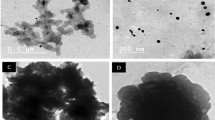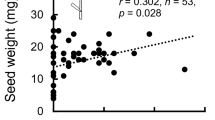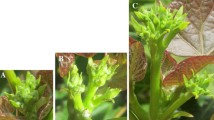Abstract
Oil seed rape (Brassica napus L.) is one of the most commonly grown crops in Central Europe, and the brassica pod midge (Dasineura brassicae Winn.) is one of the most important pests there. Insecticides against this pest applied during flowering may harm bees and other beneficial insects. The use of biostimulants such as nitrophenolates, which are not harmful to beneficial insects, can be an environmentally friendly way to control this pest. Nitrophenolates activate lignin synthesis in rape pods so the brassica pod midge is not able to penetrate pods. Nitrophenolates also regulate the efficiency of the photosynthetic apparatus, thus increasing yield. For these reasons nitrophenolates were tested in field conditions in Central Europe in 2005, 2007 and 2008. Nitrophenolates were applied on 10-m2 plots, and their effect was compared to that of conventional insecticides. The number of damaged pods and yield parameters were assessed; the lignin content as well as photosynthetic rate was measured. Expression of genes related to lignin biosynthesis was examined in Arabidopsis thaliana L. The application of nitrophenolates decreased pod damage caused by the brassica pod midge. Expression levels of four genes related to lignin biosynthesis were increased after the application of nitrophenolates. The yield was higher in nitrophenolate-treated plots, which was attributed to an increase in the intensity of photosynthesis, higher chlorophyll content and improved chlorophyll a fluorescence parameters. The results showed that nitrophenolates have potential as a protective agent, but a further study is required. The application of nitrophenolates holds promise for reducing chemical input into the environment.





Similar content being viewed by others
References
Alford DV (2003) Biocontrol of oilseed rape pests. Blackwell Publishing, Oxford
Arabidopsis Genome Initiative (2000) Analysis of the genome sequence of the flowering plant Arabidopsis thaliana. Nature 408:796–815
Atonik, Asahi Chemical Co. Ltd., Ikomagun Nara, Japan, http://www.atonik.eu/index.php, http://www.atonik.cn/cpjj-en.asp
Babuška P (2004) Asahi kompendium wiedzy. ASAHI Chemical, Japan, p 30
Bromand B (1990) Diversities in oilseed rape growing in the western Palearctic Regional Section. IOBC/WPRS Bull XIII:7–31
Budzyński W, Dubis B, Jankowski A (2008) Response of Winter oilseed rape to the biostimulator Asahi SL applied in spring. In: Monographs series: biostimulators in modern agriculture. Field Crop, Wieś Jutra, Warsaw, Poland, pp 47–55
Bynum JB, Cothren JT, Lemon RG, Fromme DD, Boman RK (2007) Field evaluation of nitrophenolate plant growth regulator (Chaperone) for the effect on cotton lint yield. J Cotton Sci 11(1):20–25
Cavell AC, Lydiate DJ, Parkin IAP, Dean C, Trick M (1998) Collinearity between a 30-centimorgan segment of Arabidopsis thaliana chromosome 4 and duplicated regions within the Brassica napus genome. Genome 41:62–69
Cerny I, Pacuta V, Porubska M (2006) Sugar beet yield and quality formation as dependent on year, variety and Atonik and Polybor 150 foliar applications. Acta Fytotechnol Zootechnol 9(2):45–48
Conrath U, Pieterse CMJ, Mauch-Mani B (2002) Priming in plant–pathogen interactions. Trends Plant Sci 7:210–216
Djanaguiraman M, Devi DD, Sheeba JA, Bangarusamy U, Babu RCH (2004a) Effect of oxidative stress on abscission of tomato fruits and its regulation by nitrophenols. Trop Agric Res 16:25–36
Djanaguiraman M, Kathirvelan P, Mannivanan V, Sheeba JA, Devi DD, Bangurasamy U (2004b) Harvest time residue of Atonik (Nitro Phenols) in tomato and cotton. Asian J Plant Sci 3(5):624–627
Djanaguiraman M, Sheeba JA, Devi DD, Bangarusamy U (2005a) Effect of Atonik seed treatment on seedling physiology of cotton and tomato. J Biol Sci 5:163–169
Djanaguiraman M, Sheeba JA, Devi DD, Bangarusamy U (2005b) Response of cotton to Atonik and TIBA for growth, enzymes and yield. J Biol Sci 5:158–162
Djanaguiraman M, Sheeba JA, Devi DD, Bangarusamy U (2009) Cotton leaf senescence can be delayed by nitrophenolate spray through enhanced antioxidant defence system. J Agron Crop Sci 195:213–224
Djanaguiraman M, Sheeba JA, Devi DD, Bangarusamy U, Prasad PVV (2010) Nitrophenolates spray can alter boll abscission rate in cotton through enhanced peroxidase activity and increased ascorbate and phenolics levels. J Plant Physiol 167:1–9
Dusser P (2007) Outlook for development of supply/demand for oilseed and oilseed products. In: Book of abstracts of the 12th international rapeseed congress, sustainable development in cruciferous oilseed crops production, Wuhan, China, Science Press USA Inc
Elzen GW, Hardee DD (2003) United States department of agriculture-agricultural research service research on managing insect resistance to insecticides. Pest Manag Sci 59(6–7):770–776
Environmental Protection Agency (EPA) (2001) Government registration. http://www.epa.gov/pesticides/chem_search/reg_actions/registration/fs_G-10_01-Aug-01.pdf. Accessed 20 Feb 2014
European Biostimulants Industry Council (EBIC) (2011) http://www.biostimulants.eu/about/what-are-biostimulants/Accessed. 20 Feb 2014
European Food Safety Authority (EFSA) (2008) Scientific Report. Conclusion on the peer reviewofsodium nitroguaiacolate, sodium o-nitrophenolate and sodium p-nitrophenolate 191, 1–130. http://www.efsa.europa.eu/en/efsajournal/doc/191r.pdf. Accessed 20 Feb 2014
Evans KA, Allen-Williams LJ (1989) Location and infestation of winter oilseed rape by the Brassica pod midge, Dasineura brassicae Winn. (Diptera: Cecidomyiidae). Med FacLandbouwwRijksuniv Gent 54:717–725
Fu S-X, Cheng H, Qi C (2009) Microarray analysis of gene expression in seeds of Brassica napus planted in Nanjing (altitude: 8.9 m), Xining (altitude: 2261.2 m) and Lhasa (altitude: 3658 m) with different oil content. Mol Biol Rep 36:2375–2386
Gawrońska H, Przybysz A, Szalacha E, Słowiński A (2008) Physiological and molecular mode of action of Asahi SL biostymulator under optima and stress conditions. In: Monographs series: Biostimulators in modern agriculture, General Aspects, Wieś Jutra, Warsaw, Poland, pp 54–76
Girke T, Todd J, Ruuska S, White J, Benning C, Ohlrogge J (2000) Microarray analysis of developing Arabidopsis seeds. Plant Physiol 124:1570–1581
Goering HK, Van Soest PJ (1990) Forage fiber analyses (apparatus, reagents, procedures, and some applications). Agric Handbook No. 379, ARS-USDA, Washington, DC
Goulet H, Huber JT (1993) Hymenoptera of the world: an identification guide to families. Agriculture Canada Research Branch, Publication 1894/E, pp 668
Gruszczyk M, Berbeć S (2004) Porównaniewpływuwybranychpreparatówstosowanychdolistnienaplonyijakośćsurowcazłocieniamaruny (Chrysanthemum parthenium L.). Annales UMCS Sec E 59(2):755–759
Guan M, Li X, Guan C (2012) Microarray analysis of differentially expressed genes between Brassica napus strains with high- and low-oleic acid contents. Plant Cell Rep 31:929–943
Kieltyka-Dadasiewicz A, Berbec S (2007) The effect of Atonik Al on motherwort (Leonurus cardiaca L.) herb yield and flavonoids content. Herba Polonica 53:171–174
Kozak M, Malarz W, Serafin-Andrzejewska M, Kotecki A (2008) The effect of sowing rate and Asahi SL biostimulator on soybean sowing and yield. In: Monographs series: biostimulators in modern agriculture, Field Crops, Wieś Jutra, Warsaw, Poland, pp 77–84
Krawczyk R, Skoczyński J (2008) Winter survival and yield of oilseed rape depending on sowing date and application of micronutrient preparation Route® acting as a growth stimulator. In: Monographs series: biostimulators in modern agriculture, Field crops, Warsaw, Poland, Wieś Jutra, pp 33–40
Krawiec P (2008) Effects of biostimulators on growth, cropping and fruit quality of chokeberry. In: Monographs series: biostimulators in modern agriculture, Fruit Crops, Warsaw, Poland, Wieś Jutra, pp 42–48
Pavela R (2010) Antifeedant activity of plant extracts on Leptinotarsa decemlineata Say. and Spodoptera littoralis Bois. larvae. Ind Crops Prod 32:213–219
Pavela R (2011) Insecticidal and repellent activity of selected essential oils against of the pollen beetle, Meligethes aeneus (Fabricius) adults. Ind Crops Prod 34:888–892
Pavela R, Kazda J, Herda G (2007) Influence of application term on effectiveness of some insecticides against brassica pod Miste (Dasineura brassicae Winn). Plant Prot Sci 2(43):57–62
Pavela R, Kazda J, Herda G (2009) Effectiveness of Neem (Azadirachtaindica) insecticides against Brassica pod midge (Dasineura brassicae Winn.). J Pest Sci 82:235–240
Przybysz A, Gawrońska H, Słowiński A (2008) The effect of Asahi SL on growth, efficiency of photosynthetic apparatus and yield of field grown oilseed rape. In: Monographs series: biostimulators in modern agriculture, Field Crops, Warsaw, Poland, Wieś Jutra, pp 7–17
Przybysz A, Janowiak F, Słowiński A, Gawrońska H (2010) Protective role of Asahi SL against drought stress. Zeszyty Problemowe Postępów Nauk Rolniczych PAN 545:199–223
Šedivý J (1983) Tersilochinae as parasitoids of insect pests of winter rape (Hymenoptera: Ichneumonidae). Contrib Am Entomol Inst 20:266–276
Skuhravý M, Skuhravý V (1960) Bejlomorky. SZN 1960:270
Stutte CA, Clark TH (1990) Radiolabeled studies of Atonik in cotton using HPLC. Altheimer Laboratory, University of Arkansas, Fayetteville, AR 72703, USA, Arysta Life Science Report
Stutte CA, Urwiler MJ, Clark TH (1987) Laboratory and field evaluation of Atonik on cotton. University of Arkansas, USA, Arysta Life Science Report
Vavrina CS (1998) Atonik plant growth stimulator: Effect on tomato under seepage irrigation in SW Florida. Vegetable Hortic. 06 April 98. www.imok.ufl.edu/veghort/pubs/sta_rpts/atoniktom97
Vogel KP, Pedersen JF, Masterson SD, Toy JJ (1999) Evaluation of a filter bag system for NDF, ADF, and IVDMD forage analysis. Crop Sci 39:276–279
Williams IH (2003) Parasitoids of brassica pod midge. In: Alford DV (ed) Biocontrol of oilseed rape pests. Blackwell Publishing, Oxford, p 386
Wilson GF, Kaczmarek LK (1993) Mode-switching of a voltage-gated cation channel is mediated by the protein kinase A-regulated tyrosine phosphatase. Nature 366:433–438
Wrochna M, Łata B, Borkowska B, Gawrońska H (2008) The effect Asahi SL of biostimulators on ornament amaranth (Amaranthus sp.) plants exposed to salinity in growing medium. In monographs series: Biostimulators in modern agriculture, Ornament and Special Plants, Wieś Jutra, Warsaw, Poland, pp 15–32
Yaneva V, Braikov D, Masheva L (2010) Effect of atonik, Citro-K and Ca-20 preparations on polyphenol composition and antioxidant activity of Mavrud Grape (Vitis viniferaL.). Oxid Comm 33:918–925
Zaller JG, Moser D, Drapela T, Schmöger C, Frank T (2008) Vect of within-weld and landscape factor on insect damage in winter oilseed rape. Agric Ecosyst Environ 123:233–238
Acknowledgments
These experiments were supported by the grant projects NAZV Mze QG 50107 and VZ MSM 6046070901 and Arysta LifeScience Poland, Ltd., and Asahi Chemical Mfg. Co., Ltd., Japan.
Author information
Authors and Affiliations
Corresponding author
Additional information
Communicated by J. J. Duan.
Rights and permissions
About this article
Cite this article
Kazda, J., Herda, G., Spitzer, T. et al. Effect of nitrophenolates on pod damage caused by the brassica pod midge on the photosynthetic apparatus and yield of winter oilseed rape. J Pest Sci 88, 235–247 (2015). https://doi.org/10.1007/s10340-014-0603-5
Received:
Revised:
Accepted:
Published:
Issue Date:
DOI: https://doi.org/10.1007/s10340-014-0603-5




